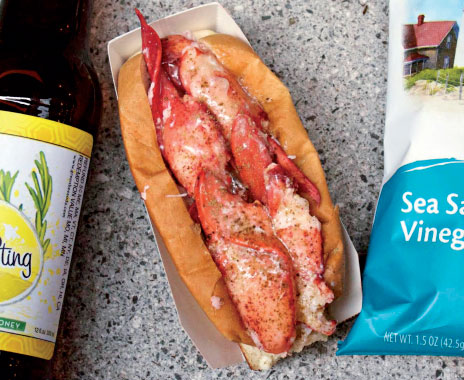A craving for Maine lobster rolls used to mean choosing between a high-end fine-dining restaurant and a roadside shack. But thanks to Luke Holden, a fast-casual option is now available in several East Coast markets.
Holden has opened outlets of his lobster roll concept, Luke’s Lobster, in New York City, Philadelphia, and Washington, D.C. The concept will expand to Chicago in June and Boston later in the year.
Despite opening restaurants far from his hometown of Cape Elizabeth, Maine, Holden remains true to his roots. Luke’s Lobster sources 100 percent of the lobster it serves from waters off the coast of Maine. Holden says he and his dad, Jeff Holden, who used to own a shellfish processing company, called upon their relationship with local lobster fishermen to directly transport fresh lobster to the restaurants. Each morning fishermen bring in their catches, which are sent to Cape Seafood, a lobster processing plant in Saco, Maine, that Holden opened with cofounder and vice president Ben Conniff in 2012 after Jeff retired.
At the plant, the lobsters are steamed and the meat is packed in protective bags for shipping to Luke’s Lobster locations.
“The best way to have a super-high-quality lobster product is to cook it as soon as it’s pulled from the ocean,” Holden says. “And food safety is paramount in our facility. It’s much higher tech than you could replicate in a kitchen.”
Holden is proud of the impact Luke’s Lobster is having on Maine’s lobster fishing community.
Luke's Lobster
Cofounder & President:
Luke Holden
HQ: New York City
Year Started: 2009
Annual Sales: $15 million
Total Units: 14
Franchise Units: 0
“The amount of lobster we buy every year probably supports 65 full-time fishermen,” he says. “And we employ 100 people in our processing plant. It’s a big deal for us to create that job stability and growth.”
Holden says Maine’s fishermen are bound by stricter regulations than their neighbors, which keeps the native lobster population robust and healthy.
“We buy lobster from Saco all the way up to the Canadian border and track it the whole way, so we know it’s coming from Maine’s sustainable fishery, not overfished waters,” Holden says.
Holden didn’t go directly into the lobster business. He studied at Georgetown University and then worked as an investment banker in New York City, where the few lobster rolls he could find were “drowning in mayo and diluted with celery, for up to $30.”
“It didn’t make sense to me,” he says. “They were not traditional and were way too expensive.”
At Luke’s Lobster, he says, the rolls are served the traditional way: pure lobster in a buttered-and-grilled, split-top bun with a swipe of mayonnaise, a sprinkle of lemon butter, and a dash of secret spices. “The key is a quarter-pound of fresh meat and letting that be the star of the show,” Holden says. The first Luke’s Lobster opened in New York’s East Village in October 2009.
While the $15 lobster rolls account for 65 percent of sales at Luke’s Lobster, other menu choices include crab rolls for $13 and shrimp rolls for $8. For variety, the Noah’s Ark includes two half rolls each of lobster, crab, and shrimp, plus four crab claws, two bags of chips, two pickles, and two sodas for $44. The Taste of Maine is a half portion of the Noah’s Ark for $23.
Soups and chowders are also available and are made for Luke’s Lobster by Hurricane’s Premium Soup & Chowder in Greene, Maine. “We sell them the seafood, and they turn it into lobster bisque and chowders that are distributed to our restaurants,” Holden says. “All we have to do is bring them up to temperature.”
Although fishermen trap lobsters year-round and the best catches come in fall, lobster rolls are often considered a summer food, Holden says, possibly due to the summertime surge of tourists in Maine. The notion that lobster rolls are a seasonal fare has trickled down to Luke’s Lobster, with a winter menu that is bolstered by the Lobster Grilled Cheese made with Gruyère cheese on Maine-made white bread for $12.
The Maine theme extends to the beverages. Luke’s Lobster serves Maine Root sodas, Maine microbrews, and Maine-bottled Poland Spring water. Some locations also sell desserts made with Maine blueberries.
Holden says Luke’s Lobster does a significant amount of catering and has a food truck for special events in New York City. For the next five years, he says, the company will likely open three to five stores a year and continue to grow in its existing markets.
Because the amount of cooking done on-site is limited, Luke’s Lobster locations are compact, averaging about 1,000 square feet, with the number of seats ranging from eight in the very first location to 45 in the largest Luke’s Lobster. Guests order at the counter and pick up the order when their number is called. The service and décor are designed to make guests feel like they are in a lobster shack on the coast of Maine, Holden says.
“We use as many reclaimed materials as possible, like dredged-up logs from Maine lakes and river bottoms that have been turned into tables and counters,” he says.
While Holden is happy to share his knowledge of lobster and all things Maine, he’s not ready to franchise . “We’re not ready to share our business,” he says.










